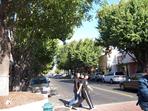Community or Public Trees
A community is defined by its trees. Trees on both public and private property comprise the urban forest and contribute to the community benefits. Trees owned by a public agency may be under the care and responsibility of the agency. Trees on private property although cared for by the private property owners may be governed by an ordinance to sustain the character and personality of the community.
It takes many years for a tree to grow and reach a size to provide the shade, air quality, storm water interception and canopy that enhance our quality of life. The quality of an urban forest is not determined by a counted number of trees. The benefits come from the area and volume of the canopy. Therefore, one new tree may not be a suitable replacement for a large healthy tree.
Public agencies typically have a tree management plan in place to guide how they care for their trees. The criteria set for prioritizing work and scheduling maintenance allows clear decision making and response to service requests and budgets. Homeowners associations and planned communities also benefit from a management plan for budgeting and making tree care decisions.
Trees are infrastructure that provide many benefits to people. Determining the optimum tree canopy and building the tree resources to meet that optimum canopy level and sustaining the canopy level is the key to maximizing our return on investment.
The tree care industry has industry standards, the American National Standards Institute (ANSI) A300 Standards for Tree Care Operations. These equate to the "Engineering Standards" and "Uniform Building Code" for trees. The current standard parts include:
Part 1 - Pruning
Part 2 - Soil Management and Fertilization
Part 3 - Support Systems
Part 4 - Lightning Protection Systems
Part 5 - Management During Construction and Development
Part 6 - Transplanting and Planting
Part 7 - Integrated Vegetation Management
Part 8 - Tree Risk Assessment
Part 9 - Root and Root Zone Management (under development)
Part 10 - Integrated Pest Management (under development)
Part 11 - Urban Forest Products (under development)
The Standards are managed under the Secretariat, the Tree Care Industry Association, and can be purchased through most professional arborist organizations and at www.tcia.org/standards/a300.htm
 Trees contribute to the
Trees contribute to the
character of downtown
Redwood City
Mann Made Resources has experience developing inventories, tree management plans, tree protection plans, infrastructure and tree issue management, pruning programs, planting programs, specification writing, grant writing, budgeting, masterplans, and ordinances. Each element should be customized to the preferences of the community. We listen to the needs of the community and work with each client to create the product that meets your needs.

Community tree species
and age diversity
The objective is to sustain the urban forest over time to receive continuous benefits from the trees. The process of evaluating the current resource and planning what level to take it to and how to sustain that new level is the challenging task. Our staff enjoys being part of the journey and assisting communities determine the target and building the programs and policies to achieve their objectives.
Mann Made Resources has been in business since 1986 providing the expertise, experience, and ability to assist you in meeting your individual tree and urban forest management needs. We work with individual trees to large populations of trees to meet your needs.
